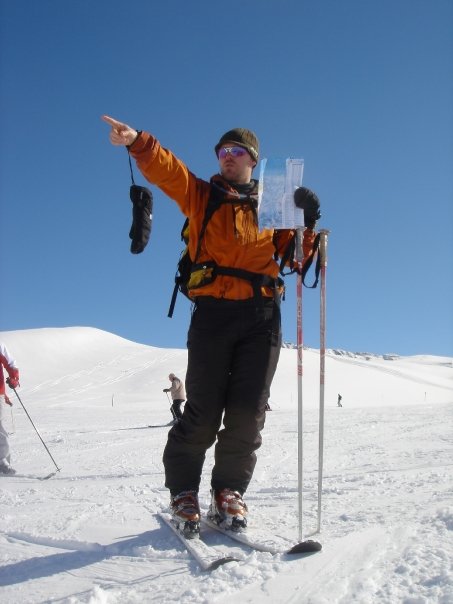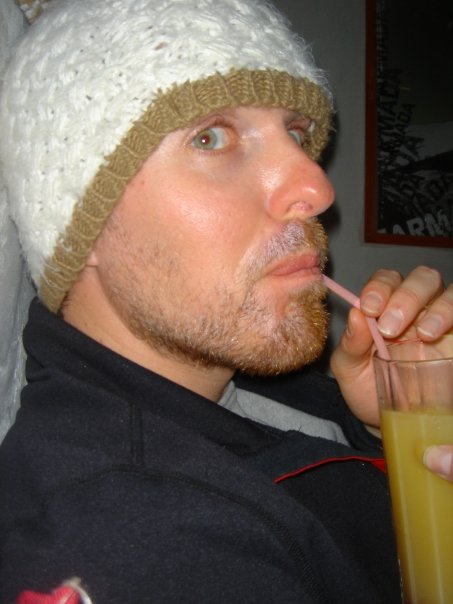Throughout my training, and through all the races that I have competed in, establishing an effective food and water intake has been something which I have struggled with. Given the lengthy duration of my long rides, it is often difficult to carry enough water on the bike, and it is also difficult to find places to refill when I’m in the middle of nowhere. It is also a great challenge to carry enough of the right food to fuel me throughout the miles. Those who have ridden the long routes with me know how suddenly I tend to ‘hit the wall’, and although I love this feeling, it is something I must try and avoid at all costs when attempting to break the record.

The man with the Nutrition Plan
So, with these last weeks before the attempt gets underway, I decided it was time to work out exactly what was needed. It turns out it is a lot more complicated than I first thought, but I think we’re decided on a set plan. I met with Nick Willsmer, a sports science and nutritionist guru from the University of Bath to help work out the right dietary plans for me to follow. He very kindly gave me some pointers in the right direction:
Having explained the gastric emptying rates and grams per hour absorption of fats, carbs, proteins and vitamins, in solid form and liquid, I was not only extremely hungry, but pretty confused. Thankfully Nick appreciated my confusion and tiredness and explained it to me in a way which just increased my hunger. “Basically, this will mean you get to eat a roast dinner, with tender lamb smothered in a subtle mint sauce, accompanied by a selection of seasonable veg, with a warm apple pie for pudding, every hour”.
In all seriousness, Nick has helped design a dietary plan to help both physically and mentally. One aspect which I have struggled with since riding such long miles, is losing all sense of normal time. By that, I mean missing meal times, instead, eating small amounts of simple sugars whenever my energy levels have felt low. This has affected me mentally more than physically, as meals (however ‘normal’) are something that I very much look forward to.
To give you an idea about why I decided to seek help with my diet, I will explain some of the common situations which happen both during and after training. For those out there who are keen-beans on their nutrition, you might well cringe, but for those of you who just like their food, you’ll understand where I was coming from!

Nick Willsmer
I very much like my food, and cycling happens to make me very hungry. So I often enjoy eating something which tastes good; something which I am used to eating, or whatever is around which tastes nice. Yet on the harder training sessions when I would be pushing myself on climbs, or maintaining a high pace over 100-150 miles, I would regularly ‘bring up’ whatever food and / or drink I had consumed. I had been religiously inputting food in preparation for climbs, and consuming just plain water in the flatter, less intense periods. Clearly, being ill in this way whilst cycling is not only uncomfortable, but it increases dehydration and was concerning me quite significantly. Plus it is quite upsetting, especially when the Lime jelly didn’t get digested (point taken – I wont get too descriptive… but you get the idea).
On other occasions, if I took something more substantial, for example, cheese and ham sandwiches, then this would make me feel extremely bloated, end up in a similar place to the lime jelly and leave me feeling uncomfortable. I was glad Nick was able to empathise with my descriptions, so I hope some of you might also – I was regularly getting that ‘full feeling’ or a ‘pressure feeling’ on my adams apple… something which was highly uncomfortable and would affect how I was riding and breathing! I needed to find something else, so I didn’t have to slow down. I very much enjoy touring by bicycle; I don’t believe there is a better way to travel, but this sitting down in a nice cafe, or at a nice picnic site to enjoy a packed lunch isn’t something I have time for, sadly. So I needed to find help.
I was also bonking (cyclist term for hitting the wall) with alarming regularity. Nick believes this is because I was consuming too much water; I had been finding anywhere with fluids and attempting to ‘stock up’ on fluid given the limited amount I can carry on my frame. This is a very school-boy error. Over consuming water is just as detrimental to being dehyrated. For those who are interested in the scientific details of why this is, I direct you to look up a condition called ‘dilutional hyponatremia’; the sodium and electrolyte levels in my blood become too dilute.
So I was making a catalogue of errors in terms of my nutritional tactics – and having explained my actions to Nick, I was educated fast about all my mistakes! 1) Excess hydration, 2) Eating the wrong foods at the wrong times, 3) Inconsistent with the types and quantities of food, 4) Continual trialing of new, ineffective plans, 5) Ineffective post-training nutrition and 6) “terrible” pre-training nutrition.
Sometimes hearing that you’ve been so far from the mark is tough, but when it’s about food, and the person telling you off is advising a food-based lesson, it doesn’t feel too bad.
Accordingly, Nick made a very important suggestion which I most certainly hadn’t considered. My nutritional intake will be matched against the route, so that fluids and food, particularly the carbohydrate intakes, are relative to the intensity of the differeng stages. This is clearly some undertaking to cover the entire 1800 miles, but something which is going to prove highly effective in getting me every bit of advantage. He has advised me to completely swap my current strategy to prevent all the sickness when working at higher intensities, and to adopt a much more ‘normal’ and simple approach to the foods which I am consuming.
While many of the available supplements are highly efficient at being absorbed and can often provide an effective response during exercise, it becomes difficult to utilise this when the exercise period is over several days. It is essential that I make every effort to avoid sharp spikes, and thus falls in my blood sugar levels.
Since meeting with Nick and designing my nutritional strategy, I have adopted the methods and plans into my training, and I am pleased to say that there has been a significant improvement. Now I just have to stick with the plans and maintain those plans throughout the six days. I can’t tell you how much I’m going to want that roast dinner over the bank holiday weekend!!


Hi, at the moment I am seeking with my iphone four new design tips and so I’ve uncovered your website. Your design and style is definitely uncomplicated but also compare it for your posts. I consider I would use it for my primary draft. Thank you for this concept!